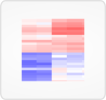No data found.

Data
RNASeq gene levels counts are produced using the featureCounts utility for subjunc alignments. The genes are first filtered to remove lowly expressed genes, which in this case involved filtering out genes with a counts per million (CPM) of greater than .25 in fewer than one third of the samples. The Conditional Quantile Normalization method was used to form GC corrected log2 reads per kilobase per million mapped reads (RPKM) values. The values were further corrected for batch, gender, collection site and tissue source using the pSVA method.
Genes are ranked by the variance of the resulting values for expression across samples. The top 1000 genes with highest variance are displayed in this view, clustered by gene and sample.
Clinical data can be added as the first rows of the plot.
Global sample-based filters affect this view. Any sample-based filters set here determine what samples (and therefore what genes) are included in this view. If no sample-based global filters are set, all are shown.
Note: if a global sample group comparison is active, the groups are annotated in the expression results, but the results are not clustered according to the groups.
Visuals
Expression values and clinical data are color-coded in tabular form.
User interactions
Drag a clinical data category to the container at right to add it to the plot. You may also expand categories by clicking on the "+", which will then allow you to drag over single values.
Clicking "Create plot" will initiate the ranking and clustering of genes and samples.
After the plot appears, click and drag over an area to display the genes and samples within. This will also allow you to download data just for those genes and samples in the selected area.








